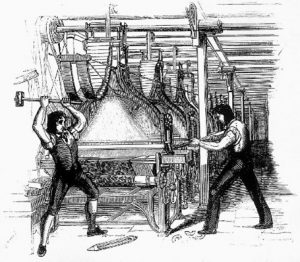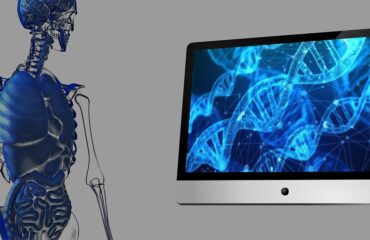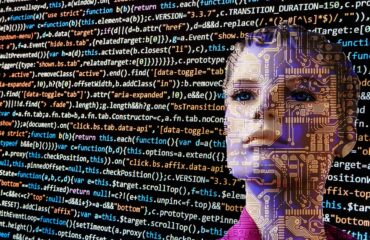What do today’s technological tools say about our belief in tomorrow’s potential?
By James Myers
Look around and it might seem you are surrounded by technology. There’s nothing new about that because in one form or another technology has been with us for thousands of years. What has changed, rapidly in the last few decades, is the extent to which technology has become a participant in our everyday actions and decisions.
Technology is a human invention, and so what does this rapid change say about our motivations and outlook on the future? What do we see of our mindsets and perception of time, reflected in our technology?
Has technology begun to shape our lives? If the answer is yes, it raises the question of what power will be left to determine the shape of your own future. How will you deal with that question – do you have to accept technology as it is and as it becomes, or will you have a say in the matter?
In many ways, the technology now used in everyday life leaves the average person with little choice but to comply. Want information on a product or business service? You have few options for the web browser and search engine you can use for that purpose, and practically no choice but to allow your query to be recorded and sold for its data value. Looking to make a purchase online? Your selection of retailers and pricing has been reduced by one company whose technology gives it a nearly unsurpassed global advantage in product sourcing and delivery. Meanwhile, sellers are left with little choice but to adapt their messaging to the algorithms of a few large platforms that they depend on to connect with their potential customers.
Today’s electronic technology has, of course, delivered much beneficial change to expand our options and extend our lives. Think of the advances in medicine enabled by computer analysis of the body’s chemistry and functions, and the diseases now controllable that would have ended in death only a generation or two ago. New technologies for electric vehicles and emissions controls are emerging that will allow us to eliminate fossil fuels, and a world of learning and information is now available online.
“Throughout our history, developments in technology have sometimes been widely embraced as positive, and sometimes feared. At all times, however, technology has been a reflection of us.”
Either way, the expanding reach of present technology will have a long-term effect more than ever before. Consider the work you are paid for, that puts food on the table and a roof over your head. If you are looking for employment or a career, chances are you will submit your qualifications to a virtual recruiter and an algorithm will determine whether you obtain an interview or the position. Seeking romance or a life partner? Many people turn to online apps for life connections, and for daily interaction there are a few dominant applications that allow us to record and present our lives and thoughts to the world. The same apps are used to target advertising to you, based on your patterns in browsing and purchasing, and to the extent you develop a desire for the advertised product it begins to establish its pattern in you. Patterns can last a long time.
What is technology now and over time?
To want some agency for yourself in a technological world is not to be anti-technology. It can, in fact, be the opposite if your use of technology is to advance knowledge and to connect with others who use it the same way. It’s not necessarily a situation of human-versus-machine in a struggle to the death, as some movies show. The Luddites, pictured in the featured image, attempted to destroy machines that replaced a need for their manual labour. Instead of breaking machines, just imagine the potential good to which technology can be applied, and the world of possibilities it could deliver, if technology is used for constructive purposes to advance the human cause.
Is there only one kind of technology we can use to build the best possible future? What is technology, and what is the cause of technology? “Technology” is a word that came into widespread use only in the past century and is now often assumed to apply only to computerized processes. However, the word’s definition has broadened over time and the evolution of its meaning in language reflects changes in human motivations over thousands of years.
From its Greek roots tékhnē (‘art’ or ‘craft’) and logia (‘expression’ or ‘explanation’), “technology” can mean our practices and our “way of doing things”, in a very general sense of doing anything. The scope of technology is not limited to computing, as it often now is. Technology can be manual, as it was for the most part of human history before the industrial revolution. In the three centuries between the onset of the industrial revolution and end of the second world war, technology became increasingly mechanical. A shovel is a device of manual technology, and a backhoe is an example of mechanical technology.
In the post-war era of the last seven decades, a very powerful electronic technology has emerged, while manual and mechanical technology are still very much in use. In the general peace of the world since the second world war ended in 1945, the creative energy of generations has been freed from a primary focus on war and destruction to invest in the testing of new ideas and to address human needs and desires. The rapid advance in technology since 1945 was in no small measure fuelled by this release of energy, and more talent yet could be put to good use if the regional battles that continue would settle peacefully.
The point is that if World War Two were still raging today, we would not have had the collective brainpower to develop the quantum computer, spaceships, the internet, the cure for smallpox, or the electric car. In fact, there wouldn’t have been many of us left at all and little medicine available to save the remaining few.
We all know that new technology doesn’t appear out of thin air. Technology is invented, based on an idea, in answer to a need or desire. Since it is invented, technology continuously evolves according to the level of understanding that exists between its inventors and users. Sometimes, particularly when there is a common purpose, the technology can be spectacularly good for the human cause. A very powerful recent example is the rapid development of the life-saving vaccine that brought the Covid-19 pandemic to heel. But for every constructive invention there is an example of its opposite, the invention that destroys. If the funding and scientific knowledge that developed the vaccine had been spent instead in a war, far greater numbers of people would have died beyond the terrible number who have already fallen victim to the plague of the virus.
Mindset on Time
The fact that we are free to apply knowledge to develop the technology of our choosing reflects the intentions that led to those choices and our estimates of their future utility. Dr. Ursula Franklin (2021-2016), who was a physicist, metallurgist, technologist, humanist, and Holocaust survivor, used the term mindset to apply to our intentions for future outcomes.
Ursula Franklin was a pioneer in understanding the consequences of particular technological mindsets, and her passionate concern for humanity was that we should never again endure a Holocaust of our own making. Ursula Franklin’s philosophy of technology, and the mindsets that develop technology, will be showcased in our next feature.
It was clear to Ursula that it is mindsets that invent and develop technology. But what are the features of a mindset – of yours or anyone else?
A mindset is not a programmable algorithmic routine that delivers certainty in its output. Quite the opposite, a mindset is far more powerful because it can adjust its own routines to manage the uncertainties of the future. In time, a programmed algorithm will fail with certainty, either to obsolescence or to adapt to need and desire. There is no such guaranteed failure with a mindset, but its future is always in question because it depends on the present reactions of other mindsets. As a result, one mindset never obtains an ability to predict outcomes with certainty, and the development of knowledge is required.
A mindset is self-adaptive, and is its own derivative. A mindset is what each of us has in our heads, that makes us individually unique. The algorithm has no mindset and is reproducible. Predictability is the hallmark of the algorithm. In fact, it is the algorithm’s purpose to produce the same results each time it is run, regardless of the number of iterations.
The algorithm is incapable of invention, nor would the algorithm care to invent. Algorithms can’t care; if they exhibit what seems to be caring it is only because they have been programmed to react in that way, under defined conditions. The algorithm is capable of doing only what it has been told – by mindsets – to do; algorithms aren’t capable of imagining incalculable probabilities. Algorithms have no need of technology, because they a part of our technology. The only uncertainties an algorithm can deal with are those that it is has been programmed – by mindsets – to handle and then only in a certain way. But we live in a universe of uncertainty, and we shouldn’t want it otherwise because the alternative would be static and pointless.
As humans, we can be grateful for the power we possess to deal with uncertainty. It is a power that is immeasurably greater than that of any algorithm. It is our human power that allows us to survive. It is a power that allows us to escape the certainties to which the algorithm is limited. Transcending certainty, human power allows us to combine our reason, spirit, and desire to navigate successfully in the universe of uncertainty.
The thing about mindsets is that they are not perfect. I will be the first to admit to the shortcomings of my mindset, and every day I work to debug its error routines and upgrade to a better version. We see many examples of imperfect mindsets, reflected in algorithms that fail when they encounter unanticipated circumstances. No human programmer is capable of perfection of either knowledge or prediction of outcomes for all of time. Mindsets are prone to error, but are tempered by caring, love, and forgiveness. Mindsets navigate uncertainty, which is inherently imperfect. Perfection of any one mindset, or all mindsets, would destroy uncertainty and with it our purpose and meaning would disappear. Can you imagine living in a universe that planned your every move in advance, leaving you with zero choice over the course of time?
As we navigate uncertainty, we can be grateful for opportunities to learn and develop new technology while guarding against potentially fatal errors. Such guardianship is the responsibility of all, not one, for the continuation of time for generations to come.
This is the point of understanding our technological mindset. Our philosophy of technology is a reflection of our intentions for the future. The more we see of the present of the direction in which we are headed, the more we retain the choice to use our technology for any necessary course corrections and for the best possible outcomes in time.

Dr. Ursula Franklin, 1921-2016
Ursula Franklin was a physicist, metallurgist, humanist, and survivor of the Holocaust that Hitler unleashed during the second world war against Jews, homosexuals, and others deemed undesirable. Sixty million souls are estimated to have perished in the history’s most horrific six years of war, from 1939-1945.
Ursula advocated for the peaceful use of technology and social justice. Her philosophy is perhaps most easily understood by her frequent expression, “Peace is not the absence of war but the absence of fear, which is the presence of justice.”
After the war and receiving her Ph.D. in experimental physics in Germany, Ursula emigrated to Canada in 1949 to work as a researcher at the University of Toronto where she later became a professor.
Ursula delivered the annual five-part Massey Lecture in 1989 to wide acclaim. She spoke on technology and its power in shaping our world, at a time when the internet and hand-held computers that are now everywhere in our lives had not been invented. Later published as The Real World of Technology, Ursula’s lectures traced the history of human technology and identified the common themes that continue to motivate technological development.
Ursula identified two categories of technology. One is prescriptive, that does not allow human choice in its application and does not adapt to human needs and practices. The other is holistic, which exists to serve human needs to which it is capable of adapting over time. By relating the human mindset to its technological practices, Ursula’s lectures demonstrated remarkable foresight for reality as we now know it, thirty-three years later.
Still very relevant, recordings of Ursula’s 1989 Massey Lecture are freely available on CBC Radio.
Perceptions of Technology Over Time
Throughout our history, developments in technology have sometimes been widely embraced as positive, and sometimes feared. At all times, however, technology has been a reflection of us.

The Luddites (“frame-breakers”) depicted smashing a loom in 1812 in protest of mechanization and loss of wages from manual labour. In the same year, the United Kingdom Parliament added the death penalty as a punishment for damage to machines. (Image source: Wikipedia)

Three former directors of the Global Smallpox Eradication Program read the news that smallpox had been globally eradicated, 1980. The technology that led to the development of the smallpox vaccine had its origin in 1796. Nearly two centuries later, knowledge was applied to perfect the technology. The worldwide smallpox vaccination campaign that began in 1958 eradicated the disease that killed up to 30% of those who contracted it and as many as 500 million people in the 100 years before the vaccination technology was developed. (Image source: Wikipedia)

Launched in 1990, the Hubble Telescope is credited with over 1.5 million scientific observations during its more than three decades in orbit 547 kilometres above Earth’s surface. A technological product of international collaboration, Hubble has added to a wide range of knowledge including the formation of stars and galaxies and the nature of dark matter. Citizen engagement with Hubble’s science is possible thanks for the technology of the internet, at https://hubblesite.org/.
(Image source: NASA)

The atomic bomb has been deployed twice in human history, in 1945 over the cities of Hiroshima and Nagasaki at the loss of nearly 200,000 lives. The technology that led to the development of the atomic bomb, which brought World War II to an end, has threatened human existence ever since. (Image source: Wikipedia)




By coincidence, Ursula Franklin lived for a time on the same street as I do currently, Lonsdale Ave. Toronto. A memorial sign has been placed in front of her home.
Your comments on Algorithms not keeping up with change have occurred more frequently than expected this year in the investment markets. Over the past 30 years, interest rates have decreased ( causing bond price levels to increase) when equities have fallen into a Bear market. Automated programmed trading added bonds to a portfolio as equity markets fell. Unfortunately in 2022 bond prices fell substantially along with equities. What appeared to reduce risk actually increased risk.